
Vomero is a bustling hilltop district of metropolitan Naples, Italy — comprising approximately two square kilometres (0.77 sq mi) and a population of 48,000.

Castel Capuano is a castle in Naples, southern Italy. It takes its name from the fact that it was at that point in the city walls where the road led out to the city of Capua. The castle is at the southwest end of via dei Tribunali, and until recently housed the Naples Hall of Justice, which has now moved to the new Civic Center, the Centro Direzionale.

The Centro direzionale is a business district in Naples, Italy, close to the station of Napoli Centrale, they constitute an entire citadel. Designed by the Japanese architect Kenzō Tange, the entire complex was completed in 1995. It is the first cluster of skyscrapers to have been built in Italy or southern Europe.

Avvocata is a quarter of Naples, southern Italy. It is just outside, to the west, of the original historic centre of the Greco-Roman city of Naples. It is the first area beyond the original city developed under the Spanish viceroyship when the Spanish moved into the Kingdom of Naples in the mid-16th century. The most prominent landmark in the area is the large square, Piazza Dante.
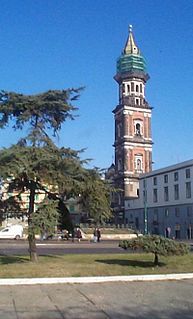
Mercato is a neighbourhood or quartiere of Naples, southern Italy. It is in the south-eastern part of the city, bounded by the industrial port of Naples on the south.
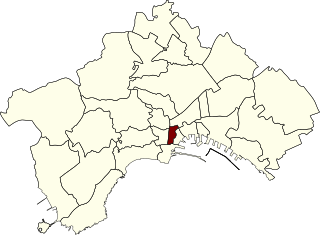
San Giuseppe is a quartiere or neighbourhood of Naples, southern Italy, which includes many of the points of interest on the western side of the historic centre of the city, including the square and church of Gesù Nuovo, the buildings along via Benedetto Croce and the square, Piazza San Domenico Maggiore.

Piazza Dante is a large public square in Naples, Italy, named after the poet Dante Alighieri. The square is dominated by a 19th-century statue of the poet Dante, sculpted by Tito Angelini.

The Four Days of Naples refers to World War II uprising in Naples, Italy, on September 28 to September 30, 1943 against Nazi German occupation forces, immediately prior to the arrival of Allied forces in Naples on October 1.

Via Toledo is an ancient street and one of the most important shopping thoroughfares in the city of Naples, Italy. The street is almost 1.2 kilometres (0.75 mi) long and starts at Piazza Dante and ends in Piazza Trieste e Trento, near Piazza del Plebiscito.

The Teatro del Fondo is a theatre in Naples, now known as the Teatro Mercadante. It is located on Piazza del Municipio #1, with the front facing the west side of Castel Nuovo and near the Molo (Dock) Siglio. Together with the Teatro San Carlo, it was originally one of the two royal opera houses of the 18th and 19th-century city.

San Michele Arcangelo or San Michele a Port'Alba is one of four major churches facing Piazza Dante in Naples, Italy. It stands near Port'Alba, a city gate opening to the piazza.

The Fontana del Gigante or Fountain of the Giant is a 17th-century monumental fountain in Naples.

The Fountain of Neptune is a monumental fountain, located in Municipio square, in Naples, Italy. The fountain until the end of 2014 was located across the street of via Medina across from the church of Santa Maria Incoronata, Naples and a few doors south of the church complex of Pieta di Turchini. Now the fountain is located in front of the Town hill building, its location changed due to the construction of the new underground station.
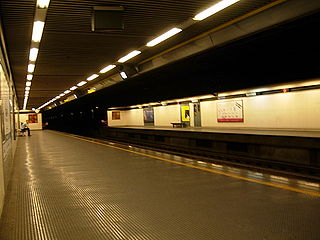
Vanvitelli is an underground metro station that serves Line 1 on the Naples Metro. It was opened on 28 May 1993 as the southern terminus of the inaugural section of Naples Metro, between Vanvitelli and Colli Aminei. On 5 April 2001, the line was extended to Museo, and Vanvitelli ceased to be the terminus.
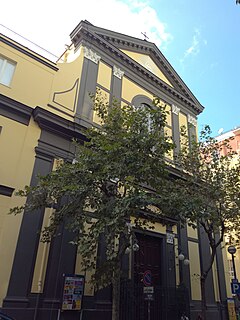
San Gennaro al Vomero is a Neoclassic-style church, located on the corner of via Solimena and via Giovanni Bernini, near the piazza Vanvitelli in Naples, Italy.

The Porta Nolana is the remnant of one of the medieval city gates in Naples, Italy. It is located in Piazza Nolana, near a local train station, Napoli Porta Nolana with the Circumvesuviana lines, and a bustling local pedestrian market, Mercato di Porta Nolano, known for seafood. It takes its name from the road that lead to Nola.

The Piazza Bellini is a plaza located in central Naples, Italy. The Via Santa Maria di Costantinopoli runs along its western side. A block to the south is the Decumanus Maximus.

The Caffè Gambrinus is a historic, private cafe or coffeehouse in Central Naples, Italy on via Chiaia. It is located in the rear of the Palazzo della Prefettura, which lies in front and to side of the Royal Palace of Naples, both of which face the Piazza del Plebiscito. The name Gambrinus is a legendary somewhat tipsy figure of joviality, and his name is used for various brands and many establishments.

The Altamuran Revolution was a three-month period of self-government of Italian town Altamura, right after the birth of the Parthenopean Republic which ousted the Bourbons and the Kingdom of Naples. The city of the Kingdom of Naples was then defeated and taken by the so-called Sanfedisti, led by cardinal Fabrizio Ruffo, after a battle on the city walls. After being defeated, most Altamurans managed to flee through Porta Bari, one of Altamura's main gates.
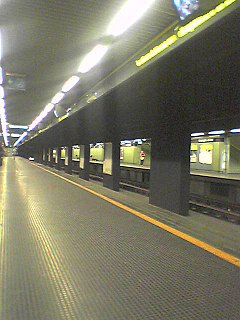
Medaglie d'Oro is a station on line 1 of the Naples Metro. It was opened on 28 May 1993 as part of the inaugural section of Naples Metro, between Vanvitelli and Colli Aminei. The station is located between Vanvitelli and Montedonzelli.




















